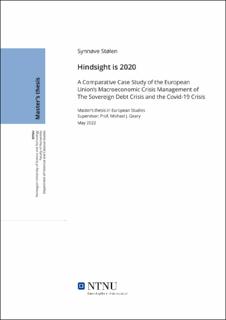| dc.contributor.advisor | Geary, Michael J. | |
| dc.contributor.author | Stølen, Synnøve | |
| dc.date.accessioned | 2022-07-06T17:22:14Z | |
| dc.date.available | 2022-07-06T17:22:14Z | |
| dc.date.issued | 2022 | |
| dc.identifier | no.ntnu:inspera:110607100:30252575 | |
| dc.identifier.uri | https://hdl.handle.net/11250/3003323 | |
| dc.description.abstract | Denne oppgaven er en omfattende analyse av den Europeiske Unions makroøkonomiske responser til Finanskrisen og Koronakrisen; to svært like kriser med vidt forskjellige responser. Den ønsker å identifisere forklaringsfaktorene som forårsaket de forskjellige responsene. Oppgaven er en komparativ casestudie som anvender most similar systems design for å undersøke the European Economic Recovery Plan, the EU-IMF Programmes, og the Next Generation EU. Oppgaven tar utgangspunkt i både kvantitative og kvalitative data, samt primær og sekundærkilder for å analysere de ulike responsene og dermed isolere faktorene som er forskjellig mellom krisene. Dette danner grunnlaget for to forskningsspørsmål: (1) Hvor mye har den økonomiske og monetære tenkingen endret seg i den Europeiske Union fra Finanskrisen til Koronakrisen?; og (2) Hvordan kan endringer i den finansielle og monetære tenkingen mellom de to krisene forklares? For å besvare disse spørsmålene danner oppgaven et grunnlag for makroøkonomisk tenkning basert på austerity, og Keynesianism, de to mest anvendte responsene til økonomiske kriser.
Oppgaven konkluderer med at den økonomiske og monetære tenkingen har forandret seg betraktelig mellom krisene, fra austerity under Finanskrisen til Keynesianism under Koronakrisen. Disse kan forklares av tre faktorer: (1) Tysklands holdninger til felles gjeld og felles respons; (2) om krisen er symmetrisk eller asymmetrisk, og forårsaket av endogene er eksogene faktorer; og (3) EUs kunnskap om å håndtere finansiell assistanse, basert på lærdom fra tidligere kriser. | |
| dc.description.abstract | This thesis provides a comprehensive analysis of the European Union’s macroeconomic responses to the Sovereign Debt Crisis and the Covid-19 crisis; two highly similar crises with significantly different responses. It aims at identifying the explanatory factors behind the diverging responses. The thesis is a comparative case study applying the most similar systems design to examine the European Economic Recovery Plan, the EU-IMF Programmes, and the Next Generation EU. The thesis draws on both qualitative and quantitative data, primary and secondary sources when analysing the responses, hence isolating the factors that diverge between the crises. This forms the basis for two research questions: (1) How far has the economic and monetary thinking changed in the European Union from the Sovereign Debt Crisis to the Covid-19 crisis?; and (2) How can the differences in the European Union’s monetary and fiscal thinking vis-à-vis the two crises be explained? To address the research questions, a foundation of macroeconomic thinking during crises is provided based on austerity, and Keynesianism, the two most frequently used responses.
The thesis concludes that the economic and monetary thinking has changed significantly between the crises, from austerity during the Sovereign Debt Crisis to Keynesianism during the Covid-19 crisis. Moreover, these differences can be explained by a set of three factors: (1) Germany’s position on common debt and collective responses; (2) whether the crisis is asymmetrical or symmetrical, and caused by endogenous or exogenous factors; and (3) the EU’s expertise in providing financial assistance, based on lessons from former crises. | |
| dc.language | eng | |
| dc.publisher | NTNU | |
| dc.title | Hindsight is 2020: A Comparative Case Study of the European
Union’s Macroeconomic Crisis Management of
The Sovereign Debt Crisis and the Covid-19 Crisis | |
| dc.type | Master thesis | |
